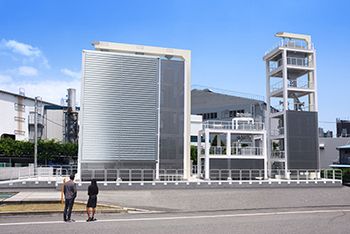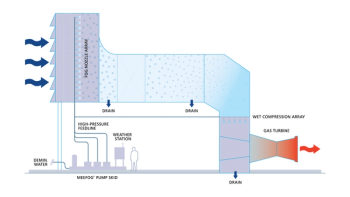
- Handbook 2023
- Volume 63
VENDOR SPOTLIGHT: EMERSON
OVATION AUTOMATION & CONTROL SOFTWARE FOR TURBOMACHINERY
Emerson is a global technology and software company headquartered in St. Louis, Missouri. It provides solutions across multiple markets and process industries, including power, oil and gas, and downstream hydrocarbons, among others. This includes technologies to manage, control, and optimize turbomachinery asset operation.
“Our portfolio includes automation & control software for turbomachinery operating in the power generation and process industries,” said Jim Nyenhuis, Manager of Performance Consulting for the Power Industry at Emerson. “More specifically, we provide turbomachinery control systems, supervisory control and data acquisition (SCADA), condition monitoring, and safety systems complemented by operations management software for asset and operations performance, data management and digital twin simulation.”
In addition, the company offers digital solutions for predictive AI-driven maintenance, remote monitoring, automated operational decision-making, and cybersecurity services designed to identify vulnerabilities, close protection gaps, and secure process control systems before an attack threatens to impact operations. For functional safety (SIL), it offers SIL3-capable safety systems together with an in-house expert team for SIL implementation on turbomachinery applications. The SIL safety system is integrated with the Emerson control system.
EVOLVING TRENDS
Nyenhuis noted several evolving trends associated with the transformation of the broader energy landscape to net zero and aggressive decarbonization. Reliance on renewables, for example, brings new challenges when working with intermittent power sources: That, in turn, requires greater asset flexibility and the necessity to closely monitor assets that operate differently than originally intended.
Workforce transitions, too, are exerting a significant impact on the industry: The accelerating loss of skilled technical workers due to Baby Boomer retirements, the mass resignation phenomenon coming out of the pandemic, and the influx of a digital native workforce generation. Combined, these factors bring to the forefront the need to address how organizations can operate and maintain equipment and facilities when faced with reduced staffing equipped with varying levels of hands-on experience.
Additionally, there is increasing interest in leveraging digitalization and data analytics taking root in an environment where many plants continue to operate with controls and automation systems of varying vintages from varying suppliers. This can impact both reliability and efficiency. It can be difficult to locate spare parts and personnel with the expertise to conduct the needed services for multiple outdated systems.
The modern plant environment calls for several elements: Quickly recognizing and responding to changing operational conditions for improved plant performance and flexibility; improving load flexibility by increasing ramp rates; better unit cycling performance and consistency; more robust and stable minimum load operation; and a decrease in the number of forced outages by reducing equipment stress.
New tools are emerging to help personnel make sense of the massive amounts of data they now collect. These tools and algorithms monitor equipment as well as process efficiency and health. When paired with various machine learning techniques and AI-based diagnostic solutions, the resulting intelligence can be used to predict and better manage potential failure situations.
EMERSON OVATION
Accordingly, Emerson offers a unified automation and software platform known as Ovation that helps to eliminate complexity and risk by capturing and contextualizing process and operational data.
“Ovation automation technology enables secure, reliable power plant, and equipment operation,” said Nyenhuis. “Emerson’s five decades of power generation expertise is embedded within Ovation software and technologies to form a digital platform that optimizes plant and equipment performance while reducing operations and maintenance costs.”
A single platform provides full power plant control, optimization, digital twin simulation, and analysis of all generating assets including major equipment, individual units, or multi-plant fleets. The software is also designed to incorporate renewable and distributed energy sources into the energy mix. It extends beyond the bounds of traditional distributed control and data acquisition systems to include integrated vibration monitoring, generator excitation control, safety instrumented systems, scalable footprints for small or distributed applications, virtualization, and embedded simulation.
Specific to the turbomachinery sector, Ovation Machinery Health Monitor integrates machinery protection and condition monitoring into an Ovation control system. The module snaps into the existing I/O base to provide continuous online monitoring of vibration and other machinery health parameters with orbit, waveform, and spectrum analysis display capabilities. Instead of alarms being generated after damage has occurred, Ovation HMIs display alerts based on sensor peak and phase values as well as Emerson PeakVue readings for rolling element bearings. Connecting the module to Emerson’s AMS Machine Works application provides condition monitoring capabilities outside of the Ovation network. A defense-in-depth approach to cybersecurity is built into the platform.
“The stress placed on rotating equipment can introduce premature component wear and other thermal and mechanical-related issues,” said Nyenhuis. “Failure events can develop slowly and quickly escalate to failure with little to no warning, putting the safety of plant operations and staff at risk. Vibration and asset monitoring solutions identify developing faults well in advance of breakdowns.”
Such technology is also being implemented in fields such as hydrogen generation, carbon capture and storage (CCS), and energy storage. For example, Mitsubishi Power America’s Advanced Clean Energy Storage Hub uses renewable electricity to power electrolyzers to produce green hydrogen. The hydrogen is then stored in salt caverns and dispatched when required to the Intermountain Power Project (IPP Renewed) to generate electricity from hydrogen-fueled turbines. Emerson is providing an integrated Ovation control and safety platform to optimize the hub’s production efficiency and help ensure safe operations.
REMOTE MONITORING
Remote, real-time access to operations is more critical than ever, especially with the increase of geographically dispersed and often unmanned assets. Emerson has made progress in the establishment of remote operations centers. Control software detects the onset of an abnormal condition and alerts the operator to take action to avert potential problems. Plant data can also be sent to a centralized monitoring and diagnostics (M&D) center for longer-term, strategic analysis across the entire fleet.
“Remote and mobile capabilities enable secure and efficient access to data from anywhere at any time,” said Nyenhuis. “This enables faster and more precise responses to critical issues, as well as the ability to proactively address maintenance issues, minimizing costs and improving safety.”
For compressor drive units, for example, progress has been made integrating the compressor and prime mover controls for easier operation and maintenance and to streamline cybersecurity protection. Such gains are enabled by many factors, including advancements in the speed and bandwidth of networking technologies.
DIGITAL TRANSFORMATION
Digital transformation is being embraced across the industry as organizations seek to boost operating efficiency, decrease downtime, and reduce costs. Advances in Internet of Things (IoT) and automation technologies are opening the door to greater levels of digitalization.
However, Nyenhuis cautions those engaged in digital transformation that while a game-changer, it can also be a disruptor. It is not only about technology.
“Organizations are increasingly factoring in not only process and technology, but also their culture—seeking buy-in from the people who will be interacting most with the technology,” he said. “This last element, commonly overlooked in the past, is essential for successful digital transformation.”
Articles in this issue
over 2 years ago
Turbo Tips: Comparing Compressorsalmost 3 years ago
Myth Busters: Impellers Should Be a Single Piecealmost 3 years ago
QA: GEARBOXES WITH VOITHalmost 3 years ago
Turbo Tour: Siemens Energy Innovation Centeralmost 3 years ago
GAS TURBINE FORECAST 2023almost 3 years ago
U.S. POWER INDUSTRY OUTLOOK 2023about 3 years ago
Handbook 2023Newsletter
Power your knowledge with the latest in turbine technology, engineering advances, and energy solutions—subscribe to Turbomachinery International today.





